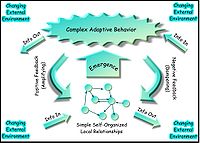
Photo from wikipedia
PurposeObstructive sleep apnea (OSA) is induced by obstruction of the upper airway, which can raise multiple health risks. This study is designed to reveal the key genes involved in OSA.MethodsGSE38792… Click to show full abstract
PurposeObstructive sleep apnea (OSA) is induced by obstruction of the upper airway, which can raise multiple health risks. This study is designed to reveal the key genes involved in OSA.MethodsGSE38792 was extracted from Gene Expression Omnibus database, including ten visceral adipose tissues from OSA patients and eight visceral adipose tissues from normal controls. Differential expression analysis was conducted using limma package, and then the functions of the differentially expressed genes (DEGs) were analyzed using DAVID database, followed by protein-protein interaction (PPI) network, and integrated regulatory network analysis was performed using Cytoscape software.ResultsA total of 368 DEGs (176 upregulated and 192 downregulated) were identified in OSA samples. Epstein-Barr virus infection (involving IL10RB, MAPK9, and MAPK10) and olfactory transduction were the main pathways separately enriched for the upregulated genes and the downregulated genes. After the PPI network was built, the top ten network nodes (such as TXN) were selected according to node degrees. Two significant PPI network modules were identified. Moreover, the integrated regulatory network was constructed.ConclusionIL10RB, MAPK9, MAPK10, and TXN might function in the pathogenesis of OSA.
Journal Title: Sleep and Breathing
Year Published: 2018
Link to full text (if available)
Share on Social Media: Sign Up to like & get
recommendations!